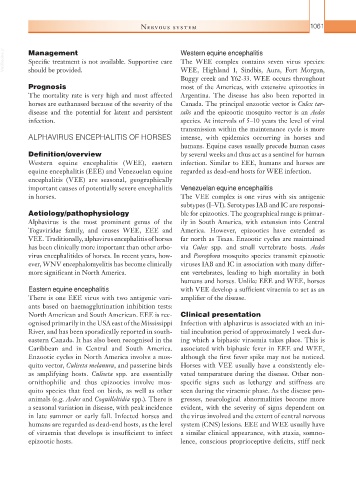Page 1086 - Equine Clinical Medicine, Surgery and Reproduction, 2nd Edition
P. 1086
Nervous system 1061
VetBooks.ir Management Western equine encephalitis
The WEE complex contains seven virus species:
Specific treatment is not available. Supportive care
WEE, Highland 1, Sindbis, Aura, Fort Morgan,
should be provided.
Buggy creek and Y62-33. WEE occurs throughout
Prognosis most of the Americas, with extensive epizootics in
The mortality rate is very high and most affected Argentina. The disease has also been reported in
horses are euthanased because of the severity of the Canada. The principal enzootic vector is Culex tar-
disease and the potential for latent and persistent salis and the epizootic mosquito vector is an Aedes
infection. species. At intervals of 5–10 years the level of viral
transmission within the maintenance cycle is more
ALPHAVIRUS ENCEPHALITIS OF HORSES intense, with epidemics occurring in horses and
humans. Equine cases usually precede human cases
Definition/overview by several weeks and thus act as a sentinel for human
Western equine encephalitis (WEE), eastern infection. Similar to EEE, humans and horses are
equine encephalitis (EEE) and Venezuelan equine regarded as dead-end hosts for WEE infection.
encephalitis (VEE) are seasonal, geographically
important causes of potentially severe encephalitis Venezuelan equine encephalitis
in horses. The VEE complex is one virus with six antigenic
subtypes (I–VI). Serotypes IAB and IC are responsi-
Aetiology/pathophysiology ble for epizootics. The geographical range is primar-
Alphavirus is the most prominent genus of the ily in South America, with extension into Central
Togaviridae family, and causes WEE, EEE and America. However, epizootics have extended as
VEE. Traditionally, alphavirus encephalitis of horses far north as Texas. Enzootic cycles are maintained
has been clinically more important than other arbo- via Culex spp. and small vertebrate hosts. Aedes
virus encephalitides of horses. In recent years, how- and Psoropbora mosquito species transmit epizootic
ever, WNV encephalomyelitis has become clinically viruses IAB and IC in association with many differ-
more significant in North America. ent vertebrates, leading to high mortality in both
humans and horses. Unlike EEE and WEE, horses
Eastern equine encephalitis with VEE develop a sufficient viraemia to act as an
There is one EEE virus with two antigenic vari- amplifier of the disease.
ants based on haemagglutination inhibition tests:
North American and South American. EEE is rec- Clinical presentation
ognised primarily in the USA east of the Mississippi Infection with alphavirus is associated with an ini-
River, and has been sporadically reported in south- tial incubation period of approximately 1 week dur-
eastern Canada. It has also been recognised in the ing which a biphasic viraemia takes place. This is
Caribbean and in Central and South America. associated with biphasic fever in EEE and WEE,
Enzootic cycles in North America involve a mos- although the first fever spike may not be noticed.
quito vector, Culiseta melanura, and passerine birds Horses with VEE usually have a consistently ele-
as amplifying hosts. Culiseta spp. are essentially vated temperature during the disease. Other non-
ornithophilic and thus epizootics involve mos- specific signs such as lethargy and stiffness are
quito species that feed on birds, as well as other seen during the viraemic phase. As the disease pro-
animals (e.g. Aedes and Coquilleltidia spp.). There is gresses, neurological abnormalities become more
a seasonal variation in disease, with peak incidence evident, with the severity of signs dependent on
in late summer or early fall. Infected horses and the virus involved and the extent of central nervous
humans are regarded as dead-end hosts, as the level system (CNS) lesions. EEE and WEE usually have
of viraemia that develops is insufficient to infect a similar clinical appearance, with ataxia, somno-
epizootic hosts. lence, conscious proprioceptive deficits, stiff neck

